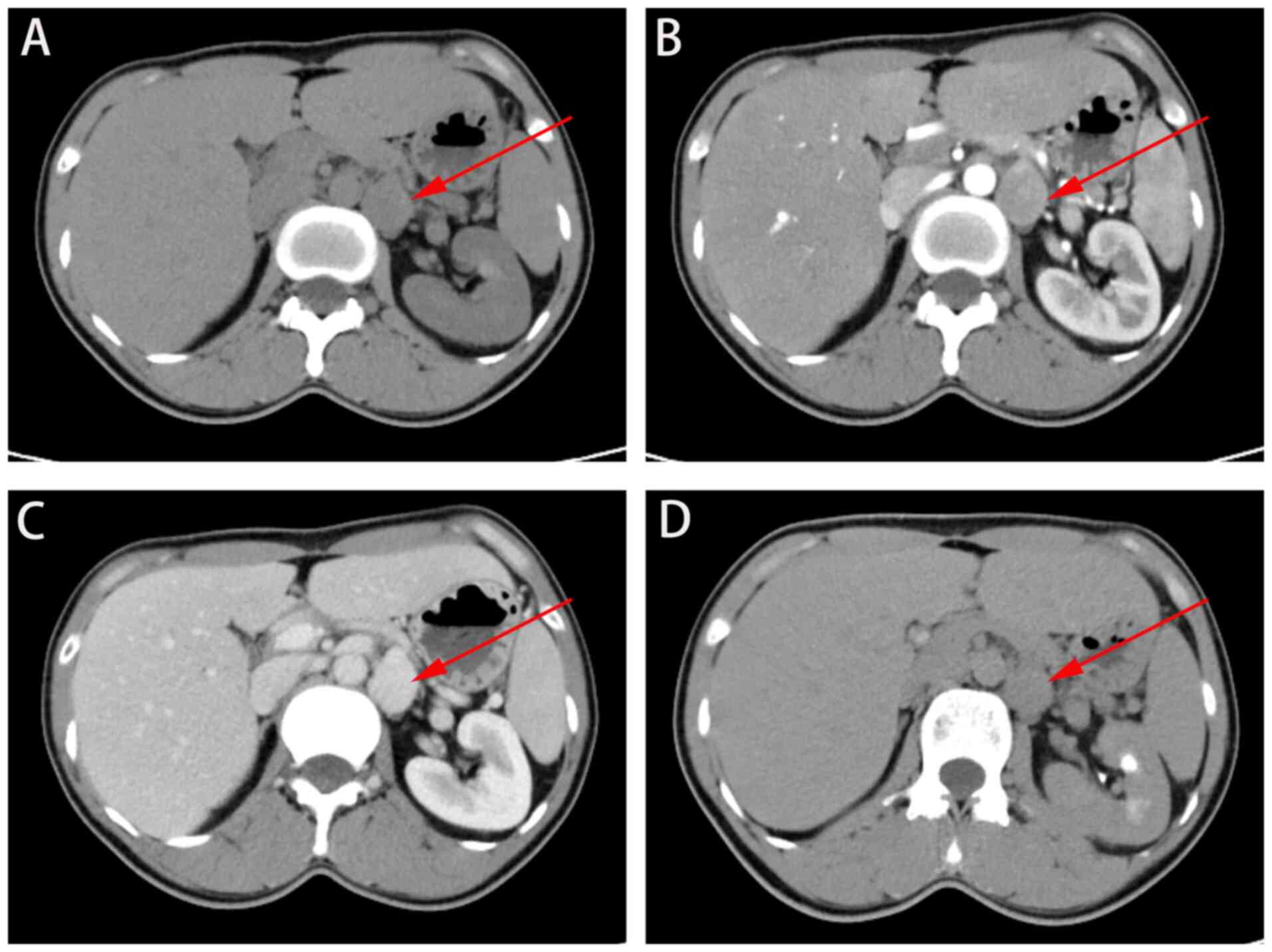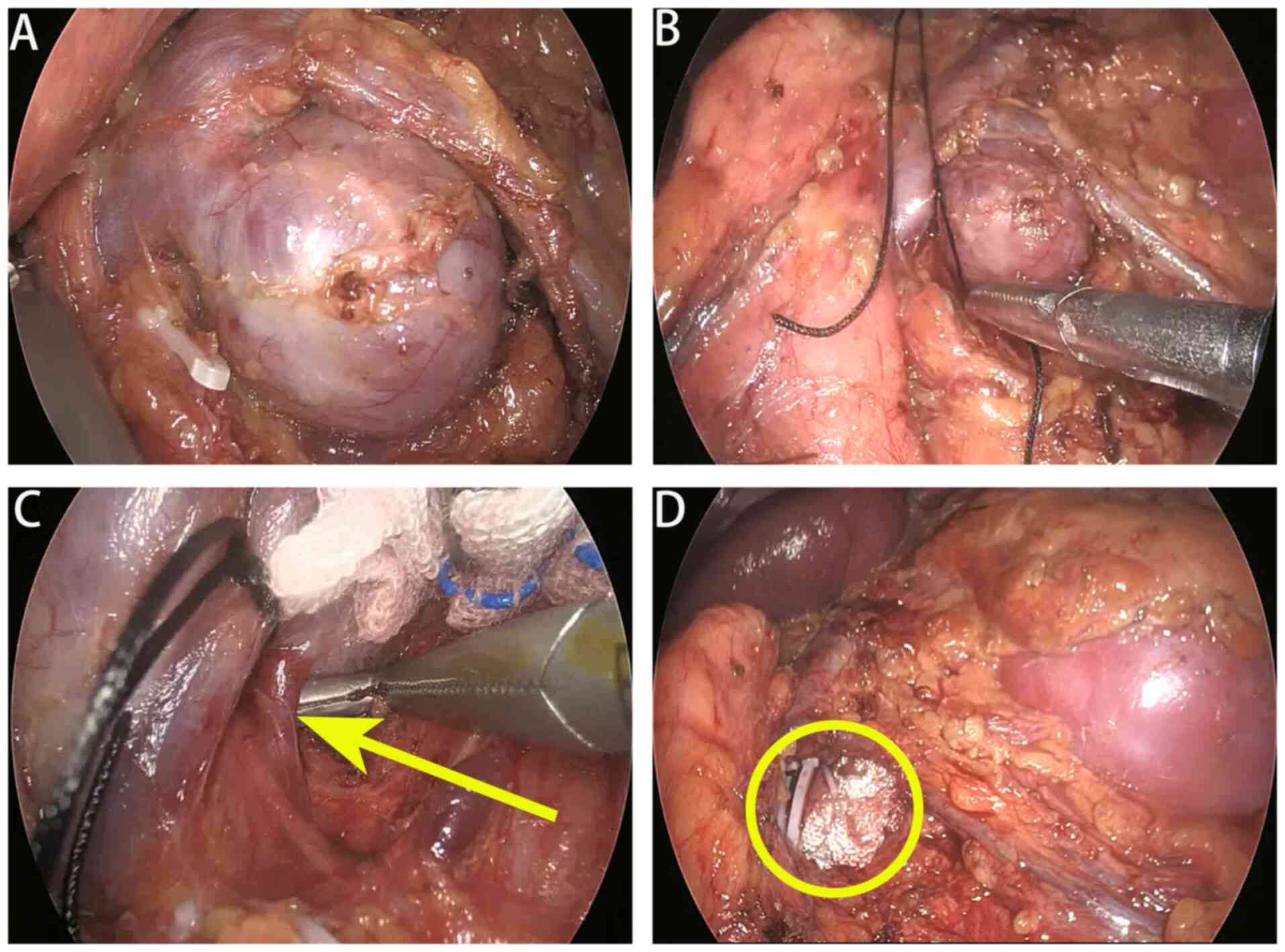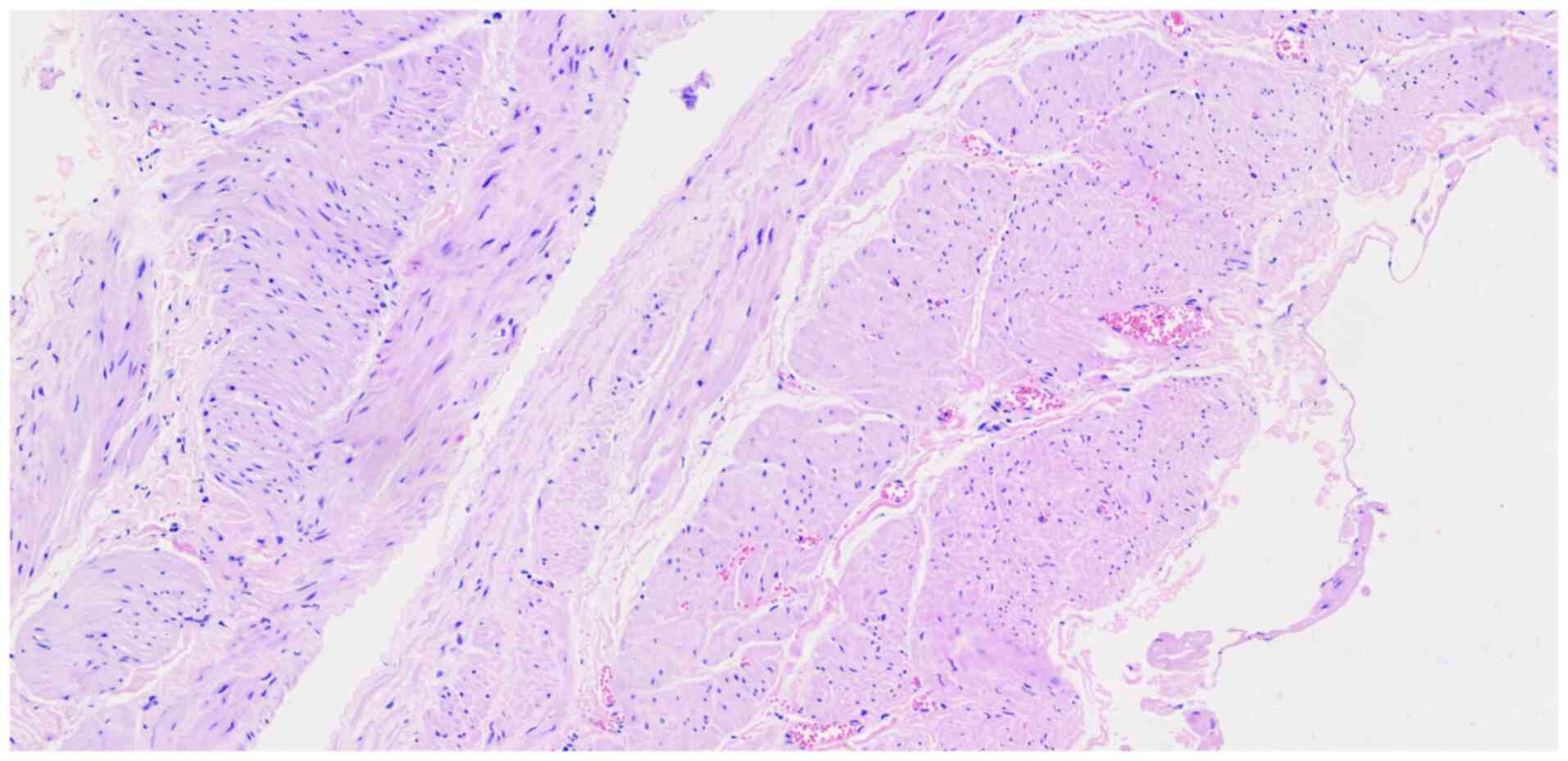Renal venous hemangioma: Report of a rare case
- Authors:
- Published online on: January 27, 2025 https://doi.org/10.3892/etm.2025.12810
- Article Number: 60
-
Copyright: © Liu et al. This is an open access article distributed under the terms of Creative Commons Attribution License.
Abstract
Introduction
A hemangioma is a benign vascular mass lesion that can occur in various parts of the body, including the kidneys, liver, head, bladder and neck. They are rare, isolated, small and usually unilateral (1-3). Hemangiomas can have sponge-like, capillary-like or fibrous shapes; however, venous hemangioma is a rarer subtype with non-specific clinical manifestations (4). Certain patients seek medical attention for hematuria; however, most patients are asymptomatic. Hemangiomas are typically discovered incidentally during physical or surgical examinations. Due to the rarity of venous hemangioma, its preoperative diagnosis is challenging and can often lead to misdiagnosis. Enhanced computed tomography (CT) cannot completely distinguish between retroperitoneal and renal venous hemangioma (5,6). Although diagnosis is challenging, these venous hemangiomas are benign with a good prognosis. Most patients receive a definitive diagnosis during surgery and ultimate confirmation through pathological examination (7). The present study reported the case of a patient with renal vein hemangioma that was initially detected as a left retroperitoneal mass on CT and confirmed via histopathological examination postoperatively.
Case report
The present study reports on a 37-year-old man with a left renal venous hemangioma. The patient presented with frequent urination for 1 week, urgency for 1 week, urethral pain for 1 week and hematuria for 1 day at Zhangye People's Hospital affiliated with Hexi University (Zhangye, China). Physical examination revealed no palpable lumps, vertebral tenderness or skin damage. Upon admission, blood examination revealed normal levels of white blood cells, red blood cells, platelets and coagulation. CT revealed a left retroperitoneal mass, considered a left adrenal tumor (Fig. 1). Surgical treatment was performed, and a 3x2.6 cm, dark-purple soft mass was found next to the left renal vein, which was compressed and deformed (Fig. 2A). A left renal venous hemangioma was suspected (Fig. 2). Left renal venous hemangioma resection was performed, resulting in the disappearance of the patient's hematuria symptoms postoperatively. Pathological examination revealed a gray-red mass with smooth wall and visible smooth muscle on hematoxylin-eosin staining; combined with clinical findings, this confirmed the presence of a left renal venous hemangioma (Fig. 3). The patient was satisfied with the treatment and recovered well before being discharged.
Discussion
Most renal hemangiomas are non-specific and asymptomatic. The majority of renal hemangiomas are discovered incidentally and occur in asymptomatic patients (8). A small percentage of patients may experience clinical symptoms, including hematuria and lower back pain. The current case report showcases that these diseases are easily misdiagnosed preoperatively due to a lack of specific clinical and imaging manifestations. Similar reports have been published in the literature, and certain patients have undergone nephrectomies. Hemangiomas and vascular sarcomas may at times appear very similar (9). On CT, their characteristic features include increased early peripheral and delayed enhancement. Abdominal cavernous hemangioma typically has distinct features on imaging, and ultrasound may be helpful in its differentiation, showing peripheral enhancement accompanied by a central hypoechoic area (10,11). These features distinguish renal hemangiomas from renal aneurysms, as well as renal tumors from adrenal tumors. However, these signs are not unique to renal vein hemangiomas and relying solely on an ultrasound diagnosis may be insufficient. Enhanced CT or magnetic resonance imaging (MRI) is required for differential diagnosis.
Renal venous hemangiomas are benign and may be associated with congenital diseases (5). The patient's family history has an important role in the genetic diagnosis of any vascular malformation; however, the patient of the present study had no family history after consultation. The incidence of spontaneous bleeding in patients with renal hemangiomas is low. However, adverse events may occur due to diseases such as vascular fragility, infarction, necrosis, cystic inflammation and increased pressure from the blood vessels. It is crucial to increase awareness of this rare disease. Preoperative imaging is essential and enhanced CT and MRI examinations can be performed if needed (6). However, mature and minimally invasive kidney surgical techniques and professional knowledge are crucial. Laparoscopic or robotic surgery at experienced medical institutions is a safe and effective treatment method.
In conclusion, the preoperative diagnosis of renal venous hemangioma is challenging because no imaging or clinical standards exist for reference. The best treatment should be tailored to a specific situation, even if the venous hemangioma is accidentally discovered during surgery, requiring temporary decision-making based on factors such as location, size and symptoms. Based on our experience, a thorough preoperative impact assessment and precise minimally invasive surgery are necessary for ensuring a good patient prognosis at professional medical institutions.
Acknowledgements
Not applicable.
Funding
Funding: This study was funded by a grant from the Hexi University 14th Science and Technology Innovation Project (grant no. 164).
Availability of data and materials
The data generated in the present study may be requested from the corresponding author.
Authors' contributions
JL, YPL and JXY contributed to the drafting of the manuscript and the design of the study. RY, LZ, XZ, JW, YQQ and JQ contributed substantially to the conceptualization and design of the study. JXY aided with the completion of the surgery. JQ and JXY approved the final version of the manuscript for publication. JQ and JY confirm the authenticity of all the raw data. All authors have read and approved the final manuscript.
Ethics approval and consent to participate
The study was conducted according to the guidelines of the Declaration of Helsinki and approved by the Ethics Committee of Hexi University affiliated Zhangye People's Hospital (approval no. B2024-026; Zhangye, China).
Patient consent for publication
Written informed consent was obtained from the patient for the publication of the patient's data/images included in this case report.
Competing interests
The authors declare that they have no competing interests.
References
|
Torrence D and Antonescu CR: The genetics of vascular tumours: An update. Histopathology. 80:19–32. 2022.PubMed/NCBI View Article : Google Scholar | |
|
Garaz R, Stühler V, Stenzl A, Rottscholl R and Amend B: Hemangioma of the urinary bladder: A brief narrative review of their diagnosis, histology, and treatment options. Urol Int. 108:83–88. 2024.PubMed/NCBI View Article : Google Scholar | |
|
Iacobas I, Phung TL, Adams DM, Trenor CC III, Blei F, Fishman DS, Hammill A, Masand PM and Fishman SJ: Guidance document for hepatic hemangioma (infantile and congenital) evaluation and monitoring. J Pediatr. 203:294–300.e2. 2018.PubMed/NCBI View Article : Google Scholar | |
|
Mansfield SA, Williams RF and Iacobas I: Vascular tumors. Semin Pediatr Surg. 29(150975)2020.PubMed/NCBI View Article : Google Scholar | |
|
Montanaro F, Bertolo R, Costantino S, De Maria N, Veccia A, Migliorini F, Caliò A, Brunelli M, Montemezzi S, Cerruto MA and Antonelli A: Robot-assisted excision of hemangioma of the right renal vein. Urol Case Rep. 53(102651)2024.PubMed/NCBI View Article : Google Scholar | |
|
Elek A, Kwon JW, Ertugrul S and Oren NC: Radiologic and pathologic correlation of a renal venous hemangioma. Int Cancer Conf J. 12:227–232. 2023.PubMed/NCBI View Article : Google Scholar | |
|
Yoshino N, Okada D, Ujiie H, Akiyama H, Nishimura Y, Koizumi K and Shimizu K: Venous hemangioma of the posterior mediastinum. Ann Thorac Cardiovasc Surg. 18:247–250. 2012.PubMed/NCBI View Article : Google Scholar | |
|
Sternberg IA, Katz BF, Baldinger L, Mano R, Paz GE, Bernstein M, Akin O, Russo P and Karlo C: Can renal hemangiomas be diagnosed preoperatively? Isr Med Assoc J. 17:157–160. 2015.PubMed/NCBI | |
|
Subramaniam A, Giani C, Napolitano A, Ravi V, Frezza AM and Jones RL: Management of vascular sarcoma. Surg Oncol Clin N Am. 31:485–510. 2022.PubMed/NCBI View Article : Google Scholar | |
|
Goncharuk RA, Rakhmonov ZA, Stegnii KV, Krekoten AA, Shulga IV and Dvoinikova ER: Combined surgical treatment of giant cavernous hepatic hemangioma: A case report. Int J Surg Case Rep. 94(107012)2022.PubMed/NCBI View Article : Google Scholar | |
|
Ferreira FG, Ribeiro MA, Abreu P, Ferreira R, Assef MS, Park JH and Szutan LA: Endoscopic Ultrasound-guided ethanol injection associated with Trans-arterial embolization of a giant Intra-abdominal cavernous hemangioma: Case report and new therapeutic option. J Gastrointest Cancer. 52:381–385. 2021.PubMed/NCBI View Article : Google Scholar |












